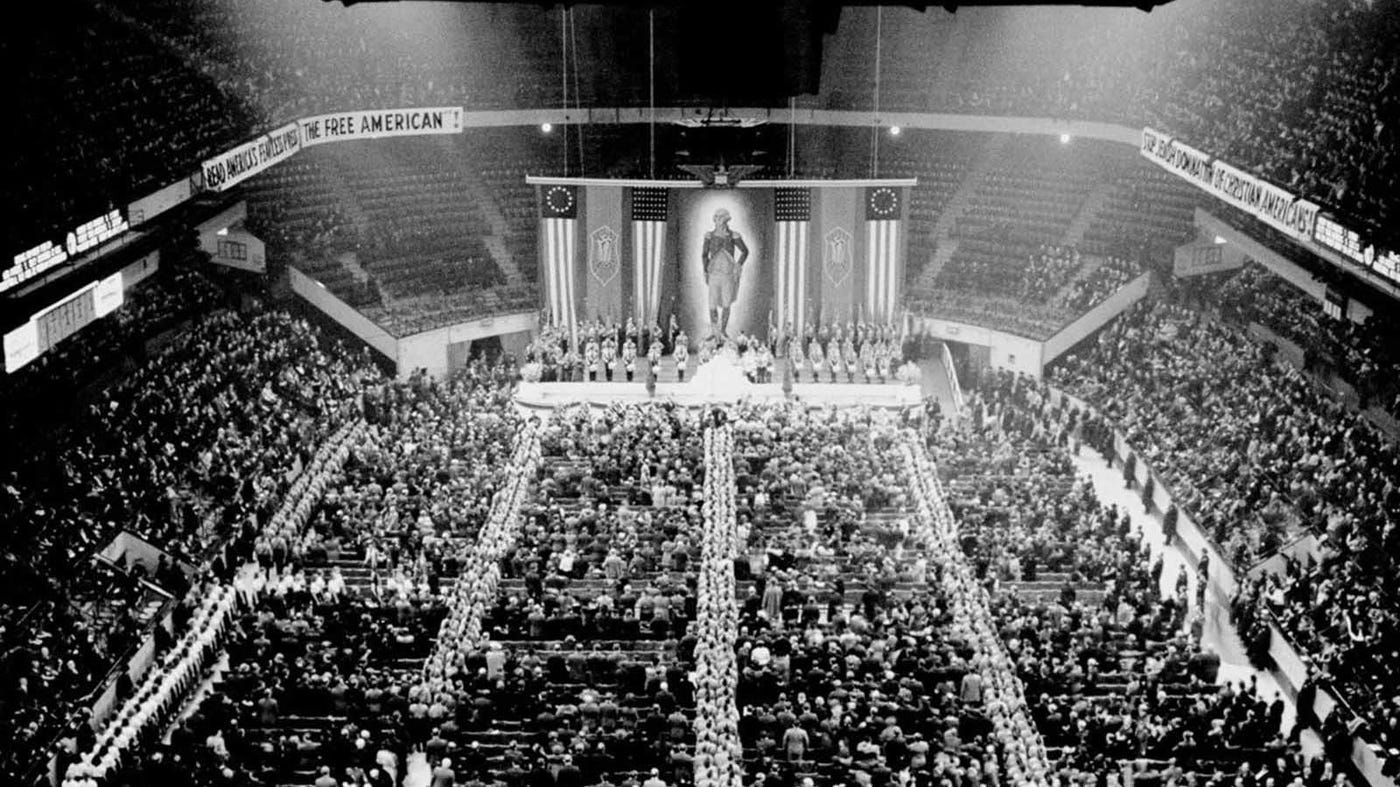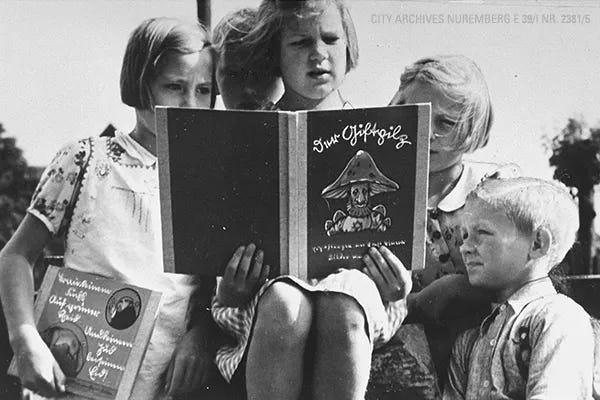Why do fascists always see themselves as the victims?
From Jim Crow to South African Apartheid and modern Israel, the answer lies in timeless fears over demographic replacement.

In his groundbreaking work The Anatomy of Fascism, the scholar Robert O. Paxton writes that, properly understood, the first truly fascist organization in the world was the Ku Klux Klan.1
Examining the historical literature regarding the Klan’s formation and their recruiting techniques reveals how deep anxieties over cultural subjugation and demographic replacement influenced the Klan’s racist and, Paxton would argue, fascist character.
Central to the Klan’s identity was the assertion of white victimhood. In the moral calculus of Klansmen, white people, and especially white women, were a perpetually vulnerable class, constantly at risk of being erased or subsumed into a terrifying sea of melanin.
This anxiety was crucial to the reassertion of formal white supremacy in places like my home state of South Carolina following the end of Reconstruction, and informal white supremacy in the years that followed. In many ways, it is still the primary node of suburban, white, conservative political alignment to this day, not only in the South, but throughout the American Heartland.
In the moral calculus of Klansmen, white people, and especially white women, were a perpetually vulnerable class, constantly at risk of being erased or subsumed into a terrifying sea of melanin.
In a demonstration of this, the Great Replacement theory–an anti-Semitic conspiracy that shadowy Global Elites are enacting a plan to demographically replace America’s white population–enjoys massive popularity in Republican circles. Times change, but old fears emerge with chilling predictability.
Herrenvolk Democracy
The Confederate States of America–and later the Southern commitment to white supremacy, as codified in the Jim Crow laws of the former Confederacy–became an early example of what is known to political scientists as a Herrenvolk Democracy. In other words, the legal codification of cultural supremacy and the full extension of democratic rights to a single chosen people at the expense of other groups.
While institutionalized racism had long been a social factor in European society, the chillingly legislative approach that the American South took towards racial exclusion offered an innovation that Europe soon adopted. To America’s shame, Southern Black Codes served as a source of inspiration for the Third Reich and its Nuremberg Laws.2
There is a reason that Hitler admired Jim Crow so much. He saw in the noble Anglo-Saxon residents of the American South a proper dedication to fencing off the the civilized, white, Christian community from the lurking barbarism of naturally criminal and violent nonwhite populations.3
To America’s shame, Southern Black Codes served as a source of inspiration for the Third Reich and its Nuremberg Laws.
The significance of this is often overlooked in historical discussions regarding the Holocaust: the greatest crime against humanity ever perpetrated proceeded slowly, by degrees, first by ostracism, then by legislative exclusion, and only in its later stages by extermination.
From this chilling historical precedent, we draw the conclusion that fascism does not always announce itself via the white hot rage of a population caught up in genocidal fury. It is more frequently manifest in the slow, procedural exclusion and ostracism of a targeted population.
This brings us to the case of Zionism. Towards the end of The Anatomy of Fascism, Paxton argues that it is with “supreme irony” that one must consider applying the dreadful label of fascism to the state of Israel.4
Paxton points out that the ongoing presence of the Palestinian population and the legacy of their oppression at the hands of Israel has pushed Israeli society further to the right and, as far back as 2004, was beginning to give it a distinctively fascist character.5

Israel’s fear of Demographic replacement
In his masterful work The Ethnic Cleansing of Palestine, Israeli historian Ilan Pappé describes what he calls ‘Fortress Israel.’ In this description, he makes a combative but salient remark regarding Zionist fears of demographic replacement:
“The aim of the Zionist project has always been to construct and then defend a Western/‘white’ fortress in the Arab/‘dark’ world. At the heart of the refusal to allow Palestinians the right to return is the fear of Jewish Israelis that they will eventually be outnumbered by Arabs in Israel.”6
Unlike Apartheid South Africa, Germany, and the Jim Crow South, Israeli Herrenvolk Democracy does not primarily rest on the notion of white identity. I say primarily, because excellent scholarly work has been done by Pappé and others that demonstrates significant overlap between European notions of white identity and Zionism’s own history of racist rhetoric and policy.
The Zionist form of fascism rests on the notion of creating a secure homeland for a persecuted Herrenvolk; a safe home for a chosen race denied their rightful place on the world stage and subjected to centuries of humiliation.
Perhaps Israeli society’s most consistent and compelling cultural reference point is that it insists on viewing Israel itself as the victim. By identifying the political project of Zionism with the very identity of the Jewish people, Israel can simultaneously portray itself as a perpetual victim while opposing any criticism of its policies with the charge that it is hatred of Jews, rather than criticism of Zionism, that animates the critic.
Fascism does not always announce itself via the white hot rage of a population caught up in genocidal fury. It is more frequently manifest in the slow, procedural exclusion and ostracism of a targeted population.
Projection and Self-Victimization
In the same way that American Christians often invoke their own persecution while enjoying truly incredible demographic and political supremacy in the United States and Europe, fascists portray–and in some cases actually believe–themselves to be victims in order to justify their political program. For the fascist, it seems feeling strong is a more elusive goal than being strong.
Fascism is boisterous and projects strength, decisiveness, and emotional resolve, but its dirty little secret is that it relies on the fascist population seeing themselves as victims. It is through their own perceived weakness that they derive the strength for political action.
This is almost universally true. The rise of fascism in Nazi Germany had a great deal to do with the German people’s sense of national shame at being turned into the whipping boy of Europe following the First World War and the repudiation of their colonial aspirations.
Russian fascism today rests on a revanchist appeal for a return to a former Golden Age and mourning Russia’s diminished status on the global stage. The airing of (mostly fictional) grievances around stories of persecuted Russian speakers in the former Soviet countries further cements the view among Russians that, like Germany before them and Israel today, they are a victim population.
This is an old tactic. After all, it was with the supposed goal of protecting German-speaking minorities in neighboring countries that Hitler launched his annexations and invasions of Czechoslovakia and Poland.
The reality is that self-victimization–whether real or imagined–is a powerful way of forming political alliances based on shared identity, and shared trauma. In the case of modern Russia and 20th Century Germany, the victimization was mostly imagined.
By identifying the political structure of Israel with the identity of the Jewish people, Israel can simultaneously portray itself as a perpetual victim while opposing any criticism of its policies with the charge that it is hatred of Jews, rather than criticism of Zionism, that animates the critic.
In the case of Israel, it is real. Perhaps more than any population on earth, the Jewish people are justified in feeling afraid of their neighbors. As one of my Israeli friends put it to me; eighty years after the Shoah, a lot of Jews mentally still live “with their bags packed and one foot out the door.”
Israel’s demographic makeup consists of some of the most historically persecuted people on earth. Herded around, victimized, and cast out from country after country, the Jewish diaspora of Europe developed resilient characteristics that allowed them to maintain their cultural distinctiveness while becoming integral parts of the communal whole of their respective countries. Yet even this could not save them from the malevolent storm of antisemitism that accompanied the rise of fascist might across Europe.
The Jewish people were marked first for ostracization, then for persecution, and finally for elimination. The Shoah did not begin with boxcars to Dachau and slit trenches in Babyn Yar. It began with a trickle of dehumanization that opened a floodgate of hatred, culminating in the worst single event of deliberate mass extinction in human history,
This process took decades. And by the time it was to late to stop it, those who witnessed the Shoah had become so accustomed to the demonization and brutalization of Jews, Roma, and queer people that they could not identify the line of demarcation where persecution transformed into genocide.
Perhaps more than any population on earth, the Jewish people are justified in feeling afraid of their neighbors.

Lessons of the Shoah and fascist victimization
The Holocaust stands among the lessons of history as what should have been an ultimate and final warning against the dangers of scapegoating vulnerable populations, runaway cultural fascism, and Herrenvolk ideology.
Yet less than a century later, the world watches in horror as some of the very tactics used by the Third Reich to mark the Jews for destructions are used today by Israelis to dehumanize the Palestinians and justify their annihilation.
It was not a given that, of all the peoples capable of committing a genocide in the 21st Century, it ended up being some of the very victims of history’s greatest crime who took up the mantle.
But was it also such a chilling surprise? Research on the multi-generational effects of trauma seem to powerfully indicate a single reality among both individuals and groups: hurting people hurt people.7
Those who witnessed the Shoah had become so accustomed to the demonization and brutalization of Jews, Roma, and queer people that they could not identify the line of demarcation where persecution transformed into genocide.
The roots of Israeli fascism
No modern figure is more emblematic of this mindset of fascist victimhood than Itamar Ben Gvir, the convicted terrorist who now serves as Israel’s Minister of National Security.
“Ben Gvir firmly frames Jews, a clear majority within Israel, as a persecuted minority” writes Uriel Abulof, associate professor of Politics at Tel-Aviv University. “Whether a soldier guarding a West Bank outpost, or a girl waiting for the bus in a diverse city, for Ben Gvir Israeli Jews are victims, constantly targeted, harassed, and degraded by Arabs. At the same time, the Jewish state is paralyzed by law and liberals.”8
Given the long history of Jewish persecution, this is not a difficult case to make to the Jewish people, among whom Zionism still enjoys a large, if shrinking, following.
Abulof directly ties the rise of Ben Gvir and others of his ilk to the creeping fascist turn in Israeli politics in the past few decades. “These souls speak of fear, shame, and humiliation seeking redemption through rage and domination—but also the love of God, “the people,” and the protective leader.”9
Professor Abulof’s observations about modern Israeli society in the age of Netanyahu and Ben Gvir neatly parallel what Robert Paxton, Jason Stanley, Anne Applebaum and others have observed about fascism: namely, it is a tribal political movement that emerges out of a sense of humiliation and loss, seeking redemption for the Herrenvolk through the power of cleansing violence.
Whether a soldier guarding a West Bank outpost, or a girl waiting for the bus in a diverse city, for Ben Gvir Israeli Jews are victims, constantly targeted, harassed, and degraded by Arabs.
But the notion of cleansing violence is not novel in the history of Zionism. The term “cleansing” was invoked explicitly in 1948 when David Ben Gurion and the Zionist paramilitary organization the Haganah commenced Operation ‘Cleansing the Leaven’ (bi‘ur hametz).
The Hebrew term refers to the process of Kashering, the cleansing and purifying of kitchen appliances and cookware to meet the strict standards of kosher dietary laws ahead of the Passover celebration.
Operation ‘Cleansing the Leaven’ was a plan for the ethnic cleansing of Haifa, and it was carried out to terrible effect. It was orchestrated by future Israeli Army Chief of Staff Mordechai Maklef who instructed his Zionist forces to liquidate “any Arab you encounter; torch all inflammable objects and force doors open with explosives.”10
As the city came under heavy shelling, the Palestinian civilian population fled in a panic to the port, where a horrific scene unfolded as Palestinian families tried desperately to flee in overcrowded boats under heavy fire.
The operation was considered a great success by the Haganah, and was repeated across most of Palestine in the following months.
As uncomfortable as it must be for Liberal Zionists to admit, the impulse towards fascist violence has been integral to Israeli society since the very beginning.
This anecdote goes a long way towards explaining the type of tradition of which Itamar Ben Gvir and his cadres believe themselves to be the standard bearers. It is these men, rather than pearl-clutching Liberal Zionists of the type we have become intimately familiar with in recent months, who represent the founding spirit of Israel. The spirit of kashering the leaven. A spirit of fire, blood, and soil.
As uncomfortable as it must be for Liberal Zionists to admit, the impulse towards fascist violence has been integral to Israeli society since the very beginning. History has demonstrated that redemptive violence, ethnic cleansing, and the scapegoating of vulnerable populations are not “bugs” within Zionism, but integral features.
Perhaps the Zionist project of Israel’s most consistent and compelling cultural reference point is that it insists on viewing itself as the victim.

Conclusions
Israel sits at a bizarre historical estuary where it simultaneously boasts perhaps the world’s most modern and sophisticated propaganda and surveillance apparatus while also being one of the world’s last nakedly colonial projects.
It is engaged in a sophisticated front of information warfare that is at the cutting edge of futuristic capabilities. However it grounds its entire project in 19th Century notions of national sovereignty and millennia old land claims that draw on some of the world’s oldest mythologies.
Israel’s much diminished reputation on the world stage is, to me, further evidence that the nation state is a poor method of organizing society and protecting vulnerable people in the 21st Century.
Israel is one of the world’s last nakedly colonial projects.
It offers many poignant observations on the limitations of nation-building, and reinforces the lessons we should have learned forty years ago after the fall of Apartheid, one of which is that ethnostates are not an effective means of protecting vulnerable people.
That is, after all, the point of Israel, is it not? Protecting historically vulnerable people?
Israel has failed to follow through on its promise to safeguard the Jewish people from persecution. Instead, it has undone decades of progress and endangered innocent Jewish people by claiming that its actions–horrible as they may be–represent the best interests of Jews.
In trying to protect Jewish people, Israel has replicated some of the very structures that led to their persecution, expulsion, and extermination at the hands of European powers and later, the Arab states.
This supreme irony reminds us that it is in only in creating truly just societies which safeguard the rights of all of their citizens–especially vulnerable minorities–that we can hope for peace.
A hopeful note
It was, after all, Jewish activists that led the charge in the last two centuries of progressive liberation movements. Turning the trauma of their historic persecution into a call to end persecution of all kinds, they challenged unjust power wherever it reigned and sacrifices for a more just future that many of them never got to see.
Even today, thousands of Jews are joining hands with their Palestinian brethren to demand a reckoning for the excesses of Zionism, following in the hallowed footsteps of greats like Norman Finkelstein, Noam Chomsky, Ilan Pappé and others.
It will not surprise me at all if it is Jewish activists who, in the memory of their persecuted ancestors, provide the final momentum necessary to topple the edifice of Zionism and turn Palestine into a just and free society of all its citizens, with liberty and equality for all, from the river to the sea.
Paxton, Robert O. The Anatomy of Fascism. New York: Alfred A. Knopf, 2004.
Whitman, James Q. Hitler's American Model: The United States and the Making of Nazi Race Law. Princeton: Princeton University Press, 2017.
Ibid.
Paxton, Anatomy of Fascism, 204.
Ibid.
Pappé, Ilan. The Ethnic Cleansing of Palestine. Oxford: Oneworld Publications, 2006.
Herman, Judith L. Trauma and Recovery: The Aftermath of Violence--from Domestic Abuse to Political Terror. New York: Basic Books, 1997.
Abulof, Uriel. "Have I Just Met the Jewish Hitler?" Washington Monthly, November 25, 2022. https://washingtonmonthly.com/2022/11/25/have-i-just-met-the-jewish-hitler/
Ibid.
Haganah Archives, 69/72, April 22, 1948.




Cause they Fucking psychopaths without any hope of cure
For an excellent history of the Jewish people in Europe and the growth of antisemitism, see part one of Hannah Arendt's Origins of Totalitarianism.